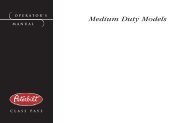Medium Duty Operator's Manual - Peterbilt Motors Company
Medium Duty Operator's Manual - Peterbilt Motors Company
Medium Duty Operator's Manual - Peterbilt Motors Company
Create successful ePaper yourself
Turn your PDF publications into a flip-book with our unique Google optimized e-Paper software.
STARTING AND OPERATING THE VEHICLE<br />
NOTE: In colder climates where the temperatures<br />
are often below freezing, sufficient warmup<br />
for turbocharged engines is especially important.<br />
Chilled external oil lines leading to the turbocharger<br />
will slow the oil flow until the oil<br />
warms, reducing oil available for the bearings.<br />
Watch the engine oil pressure gauge for a<br />
warming trend before increasing engine idle<br />
speed (rpm).<br />
3. Continue the engine warm-up until the coolant temperature<br />
reaches at least 130°F (54°C). At this temperature,<br />
you can use partial throttle. Wait until the<br />
coolant temperature is at least 160°F (71°C) before<br />
operating at full throttle. See “Operating <strong>Manual</strong><br />
Transmissions” on page 96.<br />
WARNING! Exhaust fumes from the engine<br />
contain carbon monoxide, a colorless and<br />
odorless gas. A poorly maintained, damaged,<br />
or corroded exhaust system can allow carbon<br />
monoxide to enter the cab or sleeper. Failure<br />
to properly maintain your vehicle could cause<br />
carbon monoxide to enter the cab and cause<br />
serious illnesses.<br />
WARNING! Never idle your vehicle for prolonged<br />
periods of time if you sense that<br />
exhaust fumes are entering the cab. Investigate<br />
the cause of the fumes and correct it as<br />
soon as possible. If the vehicle must be driven<br />
under these conditions, drive only with the<br />
windows slightly open. Failure to repair the<br />
source of the exhaust fumes may lead to personal<br />
harm.<br />
Idling the Engine<br />
Under most circumstances, continuous idling of your<br />
engine merely wastes fuel. In severe Arctic weather conditions,<br />
however, you may need longer idling to be sure all<br />
parts of your engine are fully lubricated.<br />
CAUTION: Do not allow your engine to idle, at<br />
low rpm (400–600 rpm), longer than five minutes.<br />
Long periods of idling after the engine<br />
has reached operating temperatures can<br />
decrease engine temperature and cause<br />
gummed piston rings, clogged injectors, and<br />
possible engine damage from lack of lubrication.<br />
The normal torsional vibrations generated<br />
can also cause transmission wear.<br />
<strong>Medium</strong> <strong>Duty</strong> (R05/09) Y53-6008A – 93 –
















